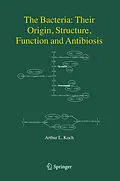Understanding antibiotic chemotherapy at the ecological level is necessary for more permanent advances in development and in the usage of antibiotic agents. This book traces the history of bacteria, from the development of life on earth to the evolution of diversity. It is this diversity that led, almost automatically to the development of pathogens as well as antibiotics. If we are to create long term antibiotics we must design them with this history in mind.
Zusammenfassung
This book may seem like three or four books even though the main - cus is on a specialized topicthe bacterial cell wall. Its job is to formulate the innovations that caused life to initiate on earth, those that caused cell physiology to develop without diversity developing, those that allowed the murein walls of the cells to arise, those that led to the separation of the domain of Bacteria from other organisms, those that allowed the Archaea and the Eukarya to develop independently, and those that then led to the development of a very diverse b- sphere. It must have taken a long time after the origin of the ?rst cell; evolution had to proceed to produce very effective organisms. At some point a collection of very similar organisms arose that were ?rst called collectively the Last U- versal Ancestor (LUA), and stable divergence developed from there. The ?rst bacterium had a protective cell wall and its descendants developed in many - verse evolutionary directions, gave rise to many species of bacteria with various life strategies, and expanded to ?ll the many niches in the collection. As the kingdoms or domains of Archaea and Eukarya evolved, many of these organisms (and even some bacteria) acted against bacteria. The dev- opment of antibiotics acting on the wall of bacteria and lytic enzymes, called lysozymes,producedbyprotozoa,plantsandanimals,ledtodestructionofmany bacteria. Theseantagonisticchallengestobacteriaresultedfromitsowncellwall structure.
Inhalt
Origin of Bacteria.- The Origin of Life Based on Physical Principles.- Preamble to Life.- The First Cell.- Development of Cell Physiology and Diversity.- Wall Structure.- Covalent Bonds and Tensile Strength of Materials.- Structure of the Fabric that Covers a Bacterium.- The Covalently Linked Sacculus: the Nona-Muropeptide Model.- The Structure of the Tessera; the Unit Structure of Murein Wall.- Extrusion and Incorporation into Wall.- The Role of Poles in the Growth Strategy of Bacteria.- Bacterial Morphologies.- Sidewalls of Gram-Negative Rod-Shaped Bacteria.- Growth Strategies for Gram-Positive Cells.- Wall Growth Strategies for Gram-Negative Cells.- Commas, Vibrios, Spirilla, and Helicobacters; Tapered and Branched Bacteria.- Spirochetes and Spiroplasma and the Special Strategies for CWD (Cell Wall Deficient) Cells.- Coccal Versus Rod-Shaped Cells, and the First Bacterium.- Diseases: Old and New.- Antibiosis.- Lysozymes as Alternatives to ?-lactams Antibiotics Acting on the Bacterial Wall.- Development of Wall Antibiotics and Bacterial Counter-Measures.- Antibiotics and Resistance, with an Emphasis on Aminoglycosides.- Future Chemotherapy Aimed at the Bacterial Murein.
Titel
The Bacteria: Their Origin, Structure, Function and Antibiosis
Autor
EAN
9781402032066
ISBN
978-1-4020-3206-6
Format
E-Book (pdf)
Hersteller
Herausgeber
Genre
Veröffentlichung
20.09.2007
Digitaler Kopierschutz
Wasserzeichen
Dateigrösse
14.76 MB
Anzahl Seiten
224
Jahr
2007
Untertitel
Englisch
Unerwartete Verzögerung
Ups, ein Fehler ist aufgetreten. Bitte versuchen Sie es später noch einmal.
